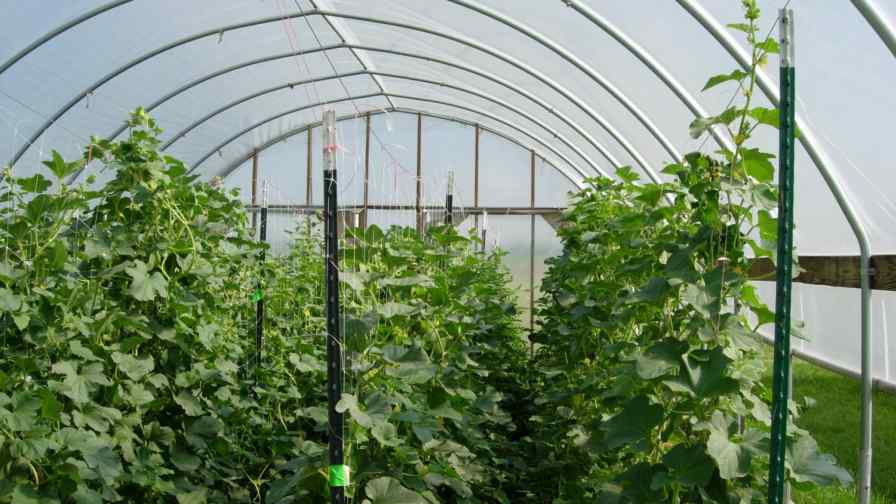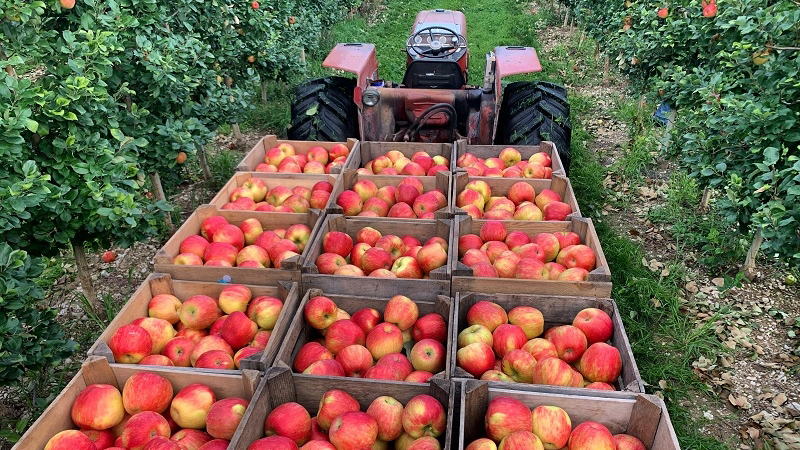Keys To Successful High Tunnel Melon Production

Selecting the proper materials, keeping your tunnel properly ventilated, and selecting proper orientations are several considerations to bear in mind during melon production.
Photo courtesy of Jett Lewis

Using high tunnels to produce melons is an excellent way to extend the season, reduce environmental stress on your crops, and produce more yields on a smaller segment of land.
Selecting the proper materials, keeping your tunnel properly ventilated, and selecting proper orientations are several considerations to bear in mind during production. Lewis Jett, Extension specialist at the University of West Virginia, zeroes in on other helpful production tips to keep your melons in top shape all season long.
Material Selection
Melons have a high base and optimal temperature for growth with the minimal temperature close to 55°F, and the high temperature between 70°F and 75°F. While melons can take temperatures into the 90s, Jett cautions growers to not allow temperatures to exceed 94.
Additionally, different covering materials combined with location will affect temperatures inside the high tunnel, Jett says.
“If a grower were in a warmer production area he could use plastic and should gravitate toward shading to keep the tunnel from getting too hot. In northern latitudes, double poly or infrared blocking plastic can be used to trap more heat,” he explains.
Material selection will also depend on whether you’re looking for an early or late market. For growers in cooler climates who would like to reach an early market, Jett recommends the use of infrared transmitting plastic which transfers heat to the soil.
“It is usually olive green or sometimes red in color. It functions similarly to clear plastic but it’s opaque enough to not allow weeds to grow through it,” Jett says.
Black plastic mulch is also used in a similar capacity for early production, while white or metallic mulch may be used for later production.
He cautions against putting the shadecloth on too early or putting on too high a percentage of shade cloth, which can spur early photosynthesis.
“Generally speaking, a shadecloth would go on early to mid-June if you’re trying to produce an early crop and reach the Fourth of July market,” he says.
Using Trellises
Many specialty melons and cantaloupes are trellised within high tunnels to improve air movement around the crop canopy and facilitate pollination by bees.
By using trellises workers don’t have to step on vines to get in to spray, prune, or pick, thus improving labor efficiency, marketable yield, and even pest management.
“By using trellises you are essentially forcing the crop to grow upright and using the warm air that rises in the tunnels to your advantage,” Jett explains.
Because melon crops are self climbing, they can be trained rather easily to grow up the trellis. There are several ways it can be done, and some examples include trellises set up on the high tunnel frames from endwall to endwall with strings descending. If you are using the high tunnel frame to support your trellis, Jett cautions to make sure your structure can withstand the weight before crops are hung from the frame.
Another option would be to create your own free standing trellises from metal ground posts that are not supported by the frame. Using cucumber trellising as a model may also be helpful as they are well suited for melon production.
Ventilation and Fans
Making sure there is enough airflow in your high tunnel is essential to optimal crop production. According to Jett, sidewall heights on high tunnels used for cantaloupe and specialty melon production should be 60 to 72 inches high to facilitate cross ventilation, and should be rolled up if internal temperatures exceed 85°F.
Gable vents, which are windows or hinged doors placed on either side of the endwalls may also be used to exhaust humid air from the crop canopy.
“They are typically 3 feet by 3 feet or 4 feet by 4 feet and are manually opened or can be automated by use of a thermostat or a solar panel,” Jett explains.
Horizontal air flow fans may also be beneficial, and can be placed every 20 feet down the length of the tunnel to create circular air movement.
Because ventilation is so crucial, your high tunnel must be placed in an area to maximize airflow. Jett suggests to locate the tunnels in an area where sidewalls are perpendicular to the prevailing winds.
“We run most of our high tunnels north to south. You want the prevailing winds during the growing season to hit the sidewalls and not the endwalls. If you run them north to south you’ll get a southwest wind and get good cross ventilation,” he explains.
Choosing Your Varieties
Jett suggests that for a commercial-sized high tunnel there be more than three marketable melons per vine, and recommends finding varieties that are highly productive per square foot. For this reason he recommends personal-sized melons.
“Standard cantaloupes are good but typically don’t produce more than three marketable cantaloupes per vine. The advantage of personal-sized cantaloupes is that they’re highly productive in tunnels, and this may be a good way for growers to segment their markets and perhaps grow the higher-end melons, maybe heirloom,” Jett explains.
He also recommends Galia melons for their high quality, and says that out of all the melons he’s trialed, they are the most profitable and competitive in the marketplace.
Choosing disease-resistant cultivars, especially those resistant to powdery mildew, should also be taken into consideration.









